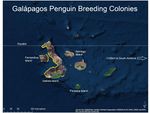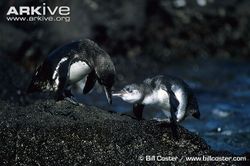Galapagos penguin
| Galapagos penguin |
|---|

|
| Scientific Classification |
|
| Scientific Name |
|
Spheniscus mendiculus |
| Image Description |
The Galapagos penguin is a species of penguin known by the scientific name Spheniscus mendiculus. It is the third smallest species of penguin in the world and are the only species of penguin found north of the equator. Being the rarest species of penguins in the world, the Galapagos penguin is classified as an endangered species after their numbers declined by 70% in the 1980’s due to the El Niño. Galapagos penguins are colonial as they live in colonies and usually stay together in groups. Most of their time is spent socializing with other Galapagos penguins in their groups. Because they live in large colonies, their numbers discourage their predators and they are able to hunt in groups. They are able to communicate with each other through calls and various body movements, like flapping their wings, which helps to keep predators away from their eggs.
Body Design
The galapagos penguin has several distinct features and characteristics. A fully grown galapagos penguin stand at an average height of about 19 to 20 inches tall and weighs an average of about 4.4 to 8.8 pounds. This makes them the second smallest species in physical size of penguin in the world.
The Galapagos penguin’s face is mostly black with a thin white line that begins at the top of each of their eyes and continues around their head all of the way down to their throat. Unlike other species of banded penguins, which have a very defined line, the Galapagos penguins white line is not defined very well. They have a long and slender beak which is black on the top part and pink, which blends into white at the middle and then into black at the tip of the beak.Just like the line on their face the Galapagos penguin has a not very well defined thick black stripe that runs up each of their legs all of the way to the top of their chest. This line is not even visible on some Galapagos penguins, who instead only have a set of black dots. They might also have a few random small round dark spots on their chest and abdomen.
Life Cycle
Galapagos penguins only have one mate at a time, but they almost always stay loyal to that mate. They irregular reproduction seasons usually occur from April to May and from August to September. The female Galapagos penguin lays two eggs in nests built within volcanic rock cavities that are found on the Galapagos Islands. It takes about a month for the chicks, baby Galapagos penguins, to grow their feathers. The chicks parents bring them food for about 65 days, which is around the time that they leave the nest, and after about 3 to 6 months they become fully independent. Even once they are independent, the juvenile penguins, young penguins, are constantly being protected by one of their parents for about a year. It can only take 2 months for a chick to become fully grown, although the growth of a penguin depends on how much food is available. The parents of a chick feed them about 20 small fish a day on average, when that much food is available. That is why chicks will grow the quickest when their are large amounts of food available.
The Galapagos penguins diet usually includes hunting and eating small fish such as mullet and sardines. But because of their small size they are preyed on by many animals both in the water and on land. On land, they are preyed upon by crabs, snakes, rice rats, cats, Galapagos hawks, and short-eared owls. In the water they are preyed upon by sharks, fur seals, and sea lions.
Ecology
As their name implies, Galapagos penguins inhabit the Galapagos Islands of Equador which are located on the equator. The galapagos penguin is the only species of penguin that lives in the northern hemisphere of the earth, which has a warm and tropical climate. The galapagos penguin can only be found in the Galapagos Islands. Their largest colonies are located on Isabela and Fernandina Islands, in the Galapagos Islands. They live surrounded by the rocky shores, found on the Galapagos Islands, that have formations of cavities that they use as shelter and to protect them from the sunlight and sandy beaches. Galapagos penguins always stay close to their colonies and will not go any farther than 3 miles away.
The Galapagos penguins live in caves and crevices that were formed by old lava flows that are close to the shore, where they can cool down from the warm climate in the cool ocean water. There is normally very little movement of the Galapagos penguin populations on the several islands that they inhabit. Although when there is a limited amount of food available for them, they will travel a farther distance away to find food.
Conservation
The Galapagos Penguin is considered to be an endangered species. Since the 1970’s, the galapagos penguins population has had large fluctuations that have placed the galapagos penguin’s small population in trouble of extinction. There has been a massive decrease in their genetic diversity, which could cause problems like their ability to adapt and overcome future diseases or changes in their source of food. The galapagos penguin population have had many years of warm, unproductive waters because of El Niño. Because of the warmer waters caused by El Niño, parent penguins have had to leave their young chicks, many of whom have died, to search for food to survive, this has caused a drop in the numbers of the galapagos penguins. Research is being done to try and stop some of the other causes of the decline in the population of the galapagos penguins.
Video
Summary of the facts about the Galapagos Penguin.
References
- ↑ Carlson, Annica. Galapagos Penguins, Spheniscus mendiculus MarineBio Conservation Society. Web. last-modified January 14, 2013. (specify whether date of publication or last-modified or accessed - i.e. Published November 3, 2015.)
- ↑ MarineBio.org. Galapagos Penguin Spheniscus mendiculus Cornell Lab of Ornithology. Web. Accessed May 1, 2018. (specify whether date of publication or last-modified or accessed - i.e. Published November 3, 2015.)




